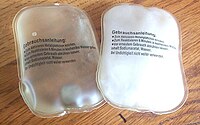
Photo from wikipedia
In the present paper, the finite element method is used to perform an exhaustive analysis of the thermal behavior of encapsulated phase change materials (EPCMs), which includes an assessment of… Click to show full abstract
In the present paper, the finite element method is used to perform an exhaustive analysis of the thermal behavior of encapsulated phase change materials (EPCMs), which includes an assessment of several materials in order to identify the best combination of PCM and shell material in terms of thermal energy storage, heat transfer rate, cost of materials, limit of pressure that they can support and other criteria. It is possible to enhance the heat transfer rate without a considerable decrease of the thermal energy storage density, by increasing the thickness of the shell. In the first examination of thermomechanical coupling effects, the technical feasibility can be determined if the EPCM dimensions are designed considering the thermal expansion and the tensile strength limit of the materials. Moreover, when a proper EPCM shell material and PCM composition is used, and compared with the current storage methods of concentrated solar power (CSP) plants, the use of EPCM allows one to enhance significantly the thermal storage, reaching more than 1.25 GJ/m3 of energy density.
Journal Title: Energies
Year Published: 2017
Link to full text (if available)
Share on Social Media: Sign Up to like & get
recommendations!